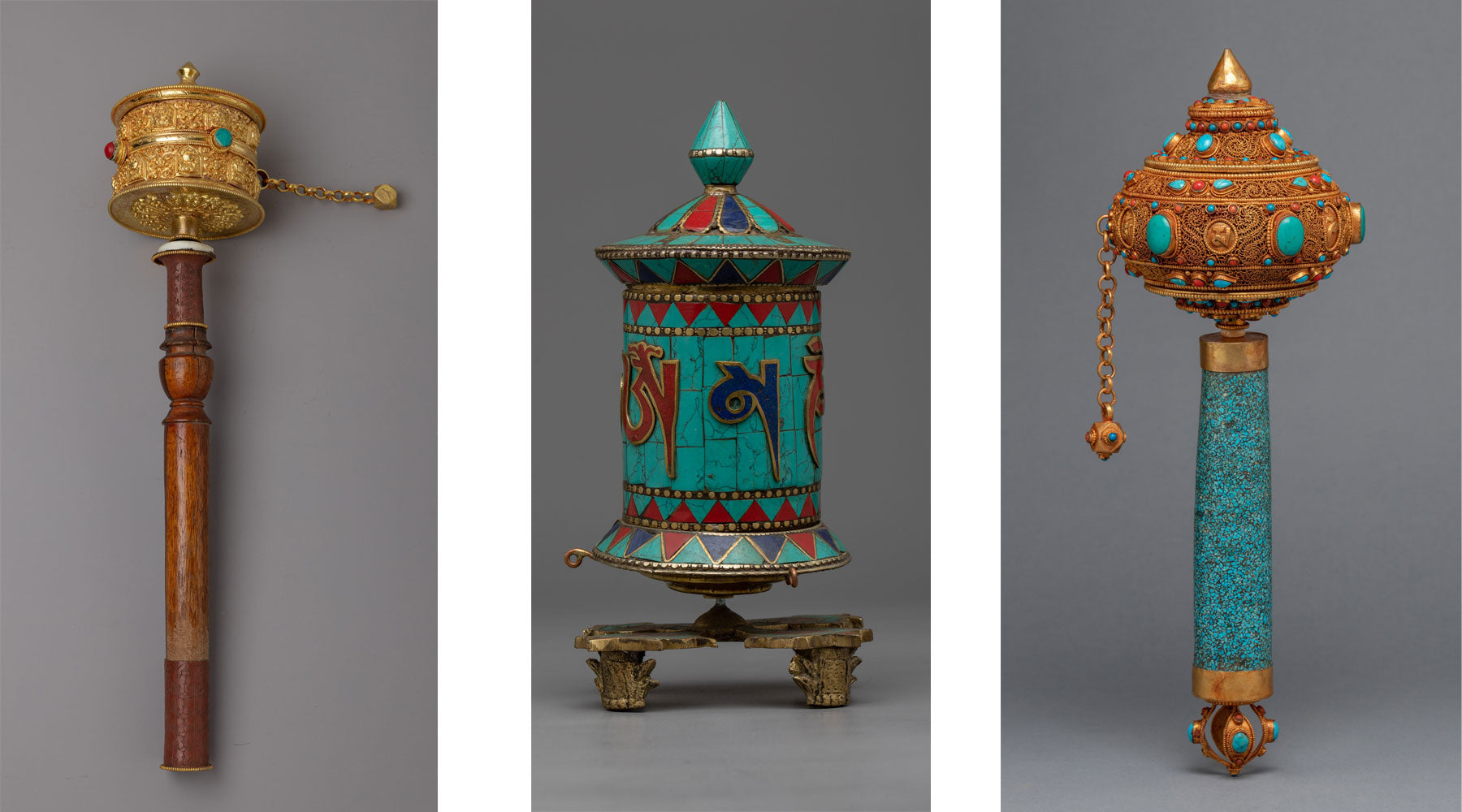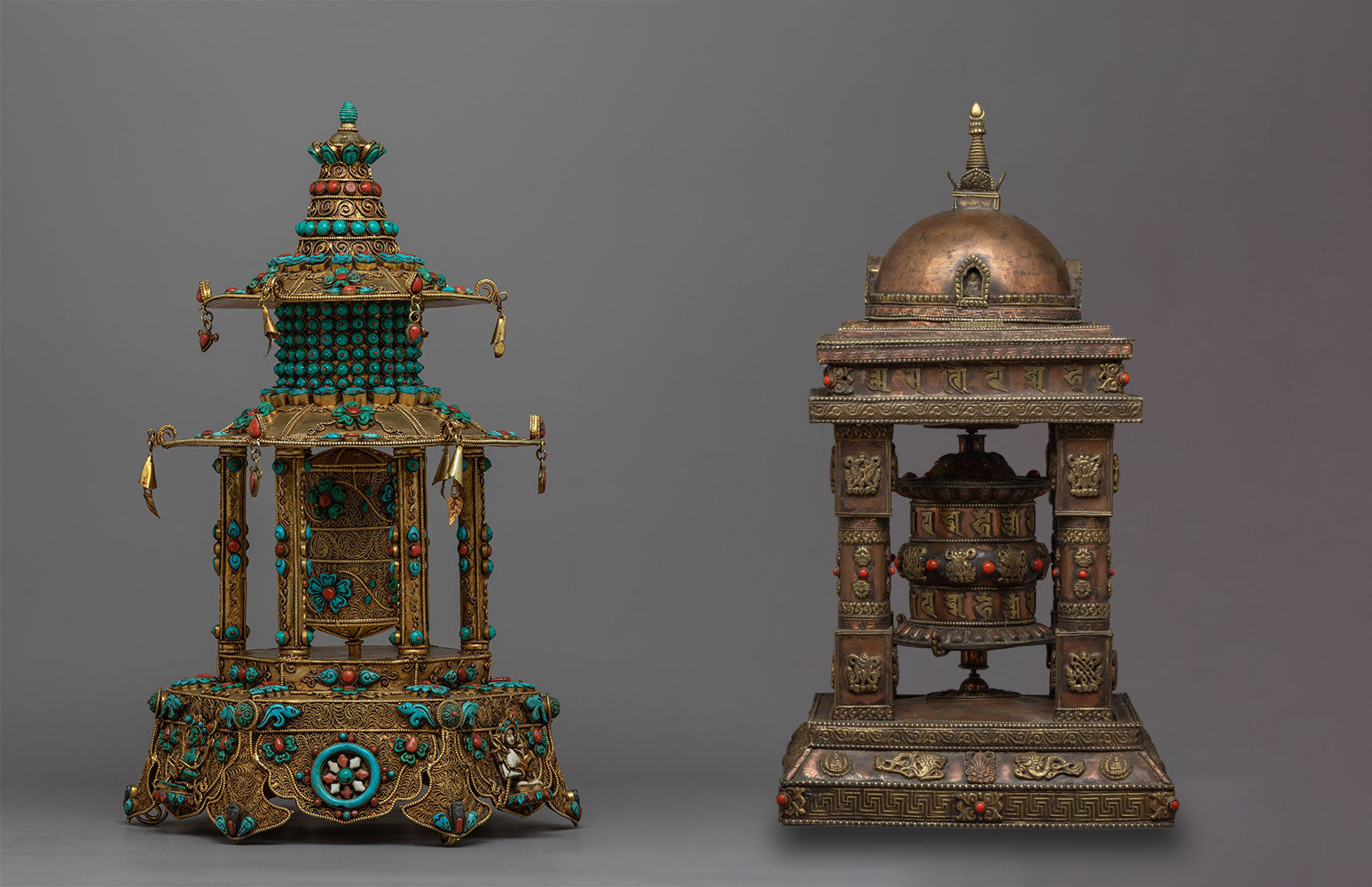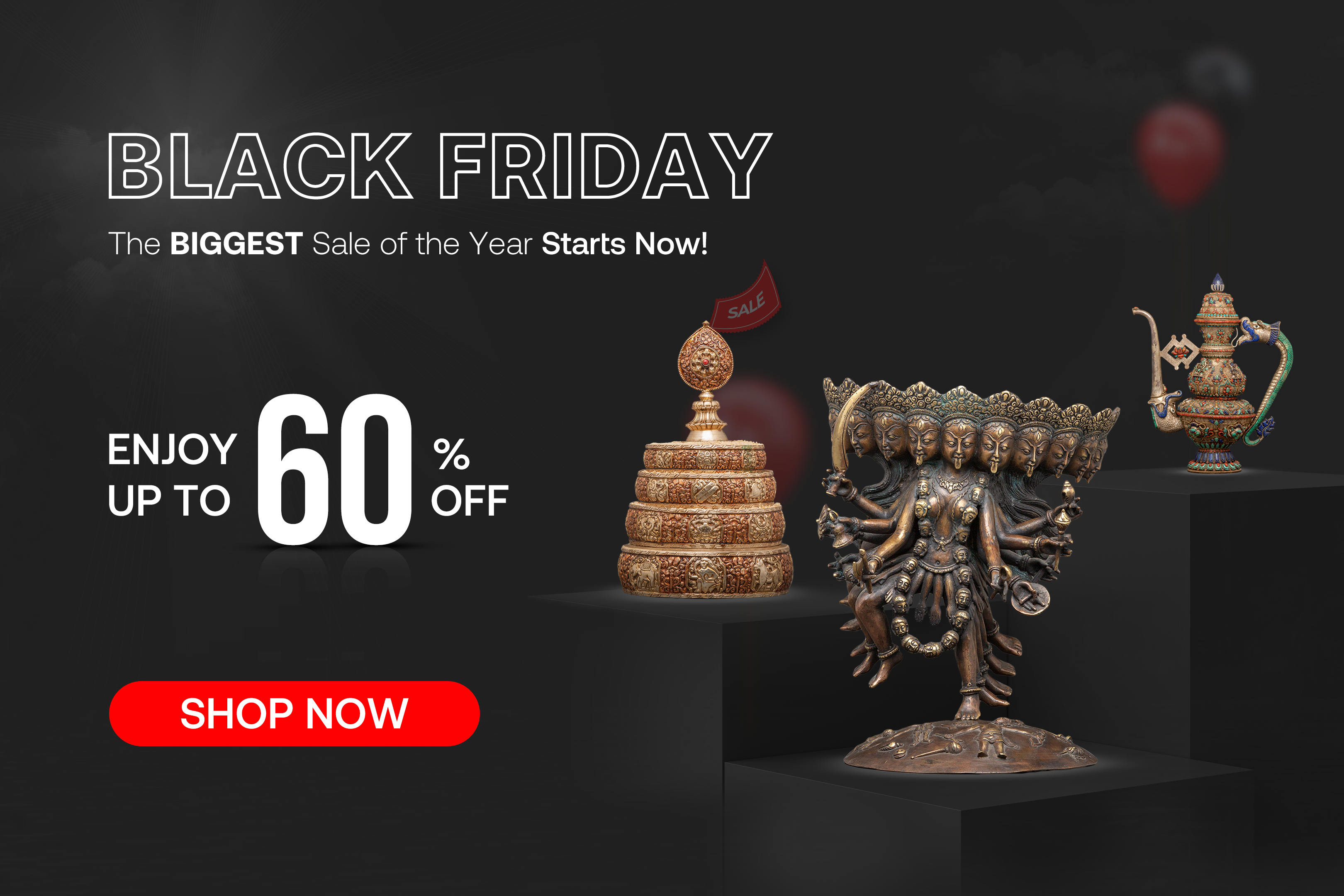The Art and Ritual of Buddhist Prayer Wheel
A key component of Buddhist practice wheels is a unique fusion of spiritual symbolism, ritual, and artistic expression. These cylinder-shaped objects, frequently engraved with holy words, are not only cultural relics; they play a significant role in Buddhist spiritual practices, especially in the Tibetan tradition.
What is a Prayer Wheel?
Prayer wheels, known in Tibet as 'Mani wheels,' are essential in Buddhist practice, particularly within the Tibetan tradition. When these wheels are spun, it is said that spiritual blessings and lessons are released into the universe; they are frequently engraved with mantras. Using prayer wheels is a profoundly ingrained Buddhist custom intended to help one gain merit knowledge and purge negativity.
Key Takeaways:
- Prayer wheels are integral to Buddhist practices, particularly in Tibetan Buddhism.
- They are inscribed with sacred mantras, most notably "Om Mani Padme Hum."
- Spinning a prayer wheel is believed to release spiritual blessings and teachings.
- Various types of prayer wheels include hand-held, stationary, water-powered, and others.
- Using prayer wheels is profoundly symbolic and tied to the pursuit of enlightenment.
Historical Background
In Buddhist tradition, using prayer wheels is a centuries-old ritual. Many people trace the practice's beginnings to the former Tibetan empire when it was created as a way for the pious to disseminate spiritual benefits and multiply their prayers.
Roots in Buddhism in Tibet
The idea of dispersing wisdom and compassion is intimately associated with the Tibetan Buddhist prayer wheel. The practice is influenced by the Buddha's teachings, which strongly emphasize the necessity of understanding for enlightenment.
Evolution Over Time
Over time, prayer wheels spread from Tibet to other Buddhist cultures, adapting in form and style but retaining its core spiritual purpose. This evolution has led to various prayer wheel types, each with unique characteristics and uses.
Types of Prayer Wheels
-
Buddhist Hand Held Prayer Wheel
Click here to view our Hand-held Buddhist Prayer Wheel

Hand-held prayer wheels are the most personal and widely used type. These are tiny enough to be spun while holding them in your hand for private prayer or meditation sessions.
| Type | Description |
| Hand-held | Portable, used for personal meditation and prayer |
-
Stationary Prayer Wheels
Click here to view our Stationary Prayer Wheel

Stationary prayer wheels are larger installations, often found in temples or monasteries. In a ritual known as circumambulation, devotees walk around the temple while spinning these wheels.
| Type | Description |
| Stationary | Large, installed in temples, spun during circumambulation |
- Water-Powered and Other Types
There are prayer wheels that run on water, wind, fire, electricity, or both, in addition to hand-held and fixed models. The wheel is spun by a distinct natural power for each kind, signifying the use of the elements to disperse spiritual benefits.
| Power Source | Description |
| Water-Powered | Utilizes flowing water |
| Wind-Powered | Driven by the wind |
| Fire-Powered | Uses heat from a flame |
| Electric | Powered by electricity |
Symbolism and Significance
Buddhism uses prayer wheels, which have a rich symbolic history. They symbolize more profound spiritual ideas found in Buddhist thought rather than just being objects of prayer.
-
Representation of Dharma
Prayer wheels represent the Dharma, or Buddhist teachings, in motion. Spinning the Wheel is believed to embody these lessons in tangible form and spread compassion and knowledge worldwide.
-
The Cycle of Samsara
The prayer wheel's round rotation also represents the samsara cycle, which is the cycle of rebirth, death, and birth. In Buddhism, turning the wheel means the journey towards enlightenment and escaping the circle of samsara.
- Propagating Wisdom and Compassion
It is thought that blessings and the lessons included in the mantras are sent forth with each turn of the prayer wheel. The fundamental principles of Buddhist practice, compassion, and wisdom, are said to be propagated via this deed.
Materials and Iconography of Prayer Wheels
In addition to serving as a spiritual tool, prayer wheels are an essential part of Buddhist practice and a monument to the rich artistic legacy of Buddhist civilizations.
Their intricate iconography and building materials are as varied and significant as the mantras they carry. This portion of the essay discusses the complex symbolism and characteristics of prayer wheel iconography while diving into the many materials utilized to create them.
Materials Used in Making Prayer Wheels
The construction of prayer wheels involves various materials, each chosen for its quality, durability, and spiritual significance. The choice of materials can vary depending on the type of prayer wheel and the region where it is made.
Common Materials
- Metal: Brass, copper, bronze, and silver are commonly used for durability and aesthetic appeal. Metal prayer wheels often feature intricate carvings and are sometimes gilded with gold or silver.
- Wood: Used primarily for the handles and sometimes for the body of hand-held prayer wheels. Wood is valued for its natural feel and is often carved or painted.
- Stone: Occasionally used for stationary prayer wheels, especially in outdoor settings. Stone prayer wheels are known for their longevity and natural beauty.
- Paper: Used for the mantras inside the prayer wheel. The paper is typically durable and able to withstand repeated rolling and unrolling.
Specialized Materials
- Precious Stones and Gems: In some cases, prayer wheels are adorned with precious stones like turquoise, coral, or lapis lazuli, adding both beauty and symbolic value.
- Silk: Often used to cover the mantra scrolls inside the wheel or as decorative elements on the wheel itself.
Iconography of Prayer Wheels
The iconography of prayer wheels is rich in symbolism, reflecting deep spiritual concepts and teachings of Buddhism.
Symbolic Elements
- Mantras: The most common mantra inscribed on or contained within prayer wheels is "Om Mani Padme Hum." This mantra is often written in Sanskrit or Tibetan script and is central to the wheel's spiritual function.
- Eight Auspicious Symbols: Many prayer wheels feature the Eight Auspicious Symbols of Buddhism, such as the Lotus (purity), the Conch Shell (the spread of the Dharma), and the Endless Knot (interconnectedness).
- Depictions of Deities: Some prayer wheels include images of Buddhist deities, like Avalokiteshvara, the bodhisattva of compassion, reinforcing the wheel's spiritual purpose.
Attributes and Design
- Cylindrical Shape: The cylindrical shape of the prayer wheel symbolizes the Wheel of Dharma, representing the teachings of the Buddha.
- Spindle: The prayer wheel's central spindle symbolizes the world's axis and is often ornately decorated.
- Handle: The handle of hand-held prayer wheels allows for ease of use and is sometimes adorned with beads or metal rings to enhance its aesthetic and tactile qualities.
Color Symbolism
- Gold and Red: Often used in prayer wheels, gold symbolizes purity and enlightenment, while red represents compassion and life force.
- Other Colors: Different colors like blue (purity of mind) and white (knowledge and learning) are also used depending on the region and tradition.
Mantras on Prayer Wheels
The most often found chant on prayer wheels is "Om Mani Padme Hum," which is connected to the compassionate bodhisattva Avalokiteshvara. This mantra is thought to have strong transformational effects and contains essential Buddhist teachings.
"OM MANI PADME HUM"
The syllable OM, present at the outset of all mantras, comprises three Sanskrit elements, symbolizing the three facets of our current existence: body, speech, and mind.
MANI, translating to "jewel," signifies the compassionate approach of an enlightened being. This compassion addresses the universal yearning for liberation from suffering.
PADME, derived from "The Padma" or lotus, embodies the wisdom of ultimate reality. Like a lotus untainted by the mud it grows in, wisdom remains pure amidst hindering conceptions of inherent self-existence.
Conclusively, the syllable HUM, incorporating five elements, represents the five Buddha families. Through attaining complete enlightenment, our ordinary mental and physical constituents transform.
Usage and Practices
The use of prayer wheels is integrated into various aspects of Buddhist practice. They are used in personal meditation, pilgrimages, and communal prayer sessions.
-
Spinning Techniques
Prayer wheels are traditionally spun clockwise to correspond with the sun's path across the sky. This path represents the transition from ignorance to enlightenment.
-
Including in Everyday Life
Prayer wheels are a common sight for many Buddhists. They serve as a tangible representation of Buddhist teachings and prayers combined with chanting, prostrations, and meditation.
Cultural and Spiritual Impact
In Buddhist communities, prayer wheels have a significant cultural and spiritual influence. They represent a group's shared religious identity and a way for individuals to grow spiritually.
-
Collective and Common Practices
Using prayer wheels is a social activity that unites individuals in common spiritual practice throughout various Buddhist cultures. The community element upholds the fundamental Buddhist teachings of empathy and compassion.
-
Creative Expression
A common feature of prayer wheels is their elaborate decorating, highlighting Buddhist civilizations' rich creative traditions. They are adorned with symbols, colors, and designs with deep spiritual meanings, making them spiritual tools and works of art.
Buddhism's prayer wheels are a complex blend of ritualistic community life, artistic expression, and spiritual practice. They are living examples of the three central tenets of Buddhism: mindfulness, compassion, and the quest for enlightenment.
These wheels keep turning whether they are used alone or in a group, dispersing blessings and prayers worldwide and serving as a constant reminder to practitioners of the possibility of awakening and transformation that is always there.















